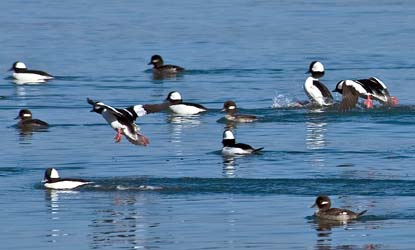Interactions
Predators
Odontosyllis phosphorea is prey to many deposit-feeding organisms and is most at risk during its reproduction cycle when it is in open water. During their reproduction period, O. phosphorea is away from the protection provided by its silky cocoon. This leaves the organism virtually defenseless and vulnerable to predators. Predators of O. phosphorea range from fish to sea horses to crabs to birds.
Fish and birds are the main predators
during the reproduction cycle when O. phosphorea is in
open water. For the duration of the cycle, the organism is in an
optimal position for birds (such as
Bucephala albeola) flying above the water to dive in the
water and consume the glowing worm. Also, fish and sea horses
(such as
Hippocampus kelloggi) swimming nearby
can consume the organism with ease due to the relative size
difference of the two organisms. A defense mechanism implemented
by O. phosphorea to prevent predators from attacking them
at the end of their reproduction cycle is the ability of females
to detach their bioluminescent tails. The glowing tail will then
act as a decoy to deter predators away from the organisms, as
O. phosphorea is able to retreat back to its silky cocoon.
glowing worm. Also, fish and sea horses
(such as
Hippocampus kelloggi) swimming nearby
can consume the organism with ease due to the relative size
difference of the two organisms. A defense mechanism implemented
by O. phosphorea to prevent predators from attacking them
at the end of their reproduction cycle is the ability of females
to detach their bioluminescent tails. The glowing tail will then
act as a decoy to deter predators away from the organisms, as
O. phosphorea is able to retreat back to its silky cocoon.
 Crabs are also a predator to O.
phosphorea in the benthic zone, where the organism lives. To
protect themselves, O. phosphorea is able to weave
cocoons out of silk. The parapodia are also another defense
mechanism used by O. phosphorea to prevent predators,
mainly crabs, from consuming them.
Crabs are also a predator to O.
phosphorea in the benthic zone, where the organism lives. To
protect themselves, O. phosphorea is able to weave
cocoons out of silk. The parapodia are also another defense
mechanism used by O. phosphorea to prevent predators,
mainly crabs, from consuming them.
Prey
Next Page: Facts